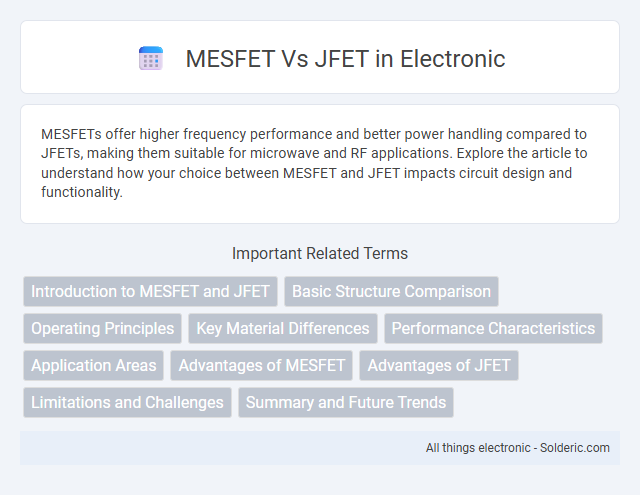MESFETs offer higher frequency performance and better power handling compared to JFETs, making them suitable for microwave and RF applications. Explore the article to understand how your choice between MESFET and JFET impacts circuit design and functionality.
Comparison Table
| Parameter | MESFET | JFET |
|---|---|---|
| Device Type | Metal-Semiconductor Field-Effect Transistor | Junction Field-Effect Transistor |
| Gate Material | Metal Schottky Gate | P-N Junction Gate |
| Semiconductor | Usually GaAs (Gallium Arsenide) | Usually Silicon |
| Operating Frequency | High frequency, suitable for microwave applications | Lower frequency compared to MESFET |
| Noise Level | Low noise, ideal for RF amplifiers | Moderate noise |
| Power Handling | Higher power capability | Lower power capability |
| Fabrication Complexity | More complex due to metal-semiconductor junction | Less complex, uses p-n junction |
| Applications | RF amplifiers, microwave circuits, satellite communications | Low-noise amplifiers, analog switching, general amplification |
Introduction to MESFET and JFET
MESFET (Metal-Semiconductor Field-Effect Transistor) and JFET (Junction Field-Effect Transistor) are both types of field-effect transistors used for amplifying high-frequency signals. MESFETs utilize a Schottky metal-semiconductor junction as the gate, making them suitable for high-speed and microwave applications, while JFETs employ a p-n junction gate that controls current through a semiconductor channel. Your choice between MESFET and JFET depends on the frequency range and power efficiency required for your electronic circuit design.
Basic Structure Comparison
MESFETs feature a metal-semiconductor junction as the gate, contrasting with JFETs which utilize a reverse-biased p-n junction gate. The MESFET's channel is typically formed in a compound semiconductor like GaAs, providing higher electron mobility compared to the silicon channel found in JFETs. Understanding these structural differences helps optimize your choice for high-frequency and low-noise amplification applications.
Operating Principles
MESFETs operate using a metal-semiconductor junction as the gate, controlling current flow through a depletion region in a semiconductor channel, typically in GaAs materials. JFETs utilize a p-n junction gate to regulate the conductivity by depleting charge carriers in the semiconductor channel, primarily silicon-based. Your choice depends on the material properties and switching speeds, with MESFETs offering higher frequency performance, while JFETs provide lower noise and simpler fabrication.
Key Material Differences
MESFETs use compound semiconductors like gallium arsenide (GaAs), offering higher electron mobility and faster switching speeds compared to JFETs, which typically employ silicon. The Schottky metal-semiconductor junction in MESFETs replaces the PN junction of JFETs, resulting in lower noise and better high-frequency performance. Your choice between MESFET and JFET depends on applications requiring speed and frequency, where MESFETs excel, versus cost-effective silicon-based devices typical of JFETs.
Performance Characteristics
MESFETs exhibit higher electron mobility and faster switching speeds compared to JFETs due to their Schottky gate structure, enhancing microwave frequency performance. JFETs provide lower noise figures and better thermal stability, making them suitable for low-frequency analog applications. MESFETs excel in high-frequency amplification with superior power handling, while JFETs offer simpler fabrication and efficient operation in low-power circuits.
Application Areas
MESFETs are extensively used in high-frequency and microwave applications such as radar systems, satellite communications, and wireless infrastructure due to their superior electron mobility and high power handling capabilities. JFETs find application in low-noise analog circuits, switching devices, and amplifiers in audio and instrumentation systems, benefiting from their high input impedance and low noise characteristics. Both devices serve critical roles in radio frequency (RF) and analog signal processing, but MESFETs dominate where high-frequency performance and power efficiency are crucial.
Advantages of MESFET
MESFETs offer higher electron mobility due to their use of compound semiconductors like GaAs, resulting in faster switching speeds and better high-frequency performance compared to silicon-based JFETs. They exhibit lower noise figures, making MESFETs ideal for microwave and RF amplifier applications. Their greater power handling capability and robustness under high electric fields provide significant advantages in communication and radar systems.
Advantages of JFET
JFETs offer lower noise figures and simpler fabrication compared to MESFETs, making them ideal for low-noise applications. Their voltage-controlled operation requires minimal input current, improving energy efficiency in analog circuits. Your choice benefits from JFETs' enhanced thermal stability and high input impedance in sensitive signal processing.
Limitations and Challenges
MESFETs face limitations such as higher fabrication complexity and sensitivity to surface states, which can degrade performance and increase noise levels. JFETs encounter challenges like lower frequency response and limited power handling capabilities compared to MESFETs, restricting their use in high-speed and high-frequency applications. Both devices require careful thermal management and precise control of doping profiles to optimize device reliability and performance.
Summary and Future Trends
MESFETs offer higher electron mobility and faster switching speeds compared to JFETs, making them suitable for high-frequency applications like microwave and RF circuits. JFETs, known for their lower noise and simpler fabrication, remain preferred in low-frequency and analog signal processing. Future trends indicate MESFETs advancing with gallium nitride (GaN) materials for improved power efficiency, while JFETs evolve toward integration in low-power, high-precision sensors; your choice depends on the specific application requirements.
MESFET vs JFET Infographic

 solderic.com
solderic.com